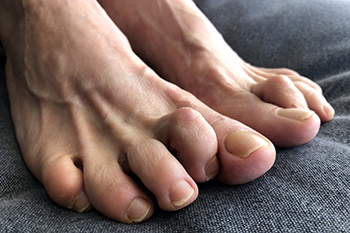Hammertoe, Mallet Toe and Claw Toe
Tuesday, 26 July 2022 00:00
For most people, toe deformities show up later in life, often as the result of wearing improper or ill-fitting footwear for many years. These deformities also can be caused by nerve or muscle damage, as well as a number of other conditions. The three most common deformities of the toe joints are similar but not the same: hammertoe, mallet toe, and claw toe. The toes have a number of joints, two in the big toe and three in the other toes. Hammertoe and mallet toe affect one joint. Claw toe affects all three joints. Hammertoe occurs when the middle joint bends down to the floor, causing the other joints to bend up. This results in a bump on the top of the toe. With a mallet toe, most common to the 2nd toe, the end joint flexes permanently, preventing the toe from straightening. Claw toe occurs when the two end joints flex and curl the toe downward. As a result the first joint compensates by hyperextending, resulting in a curled toe that looks like a claw. It often affects the four smaller toes. If you have developed any of these deformities, please consult a podiatrist for an exam and possible treatment options.
Hammertoe
Hammertoes can be a painful condition to live with. For more information, contact one of our podiatrists from Family Foot Care. Our doctors will answer any of your foot- and ankle-related questions.
Hammertoe is a foot deformity that affects the joints of the second, third, fourth, or fifth toes of your feet. It is a painful foot condition in which these toes curl and arch up, which can often lead to pain when wearing footwear.
Symptoms
- Pain in the affected toes
- Development of corns or calluses due to friction
- Inflammation
- Redness
- Contracture of the toes
Causes
Genetics – People who are genetically predisposed to hammertoe are often more susceptible
Arthritis – Because arthritis affects the joints in your toes, further deformities stemming from arthritis can occur
Trauma – Direct trauma to the toes could potentially lead to hammertoe
Ill-fitting shoes – Undue pressure on the front of the toes from ill-fitting shoes can potentially lead to the development of hammertoe
Treatment
Orthotics – Custom made inserts can be used to help relieve pressure placed on the toes and therefore relieve some of the pain associated with it
Medications – Oral medications such as anti-inflammatories or NSAIDs could be used to treat the pain and inflammation hammertoes causes. Injections of corticosteroids are also sometimes used
Surgery – In more severe cases where the hammertoes have become more rigid, foot surgery is a potential option
If you have any questions please contact our offices located in Valatie and Albany, NY . We offer the newest diagnostic and treatment technologies for all your foot and ankle needs.



